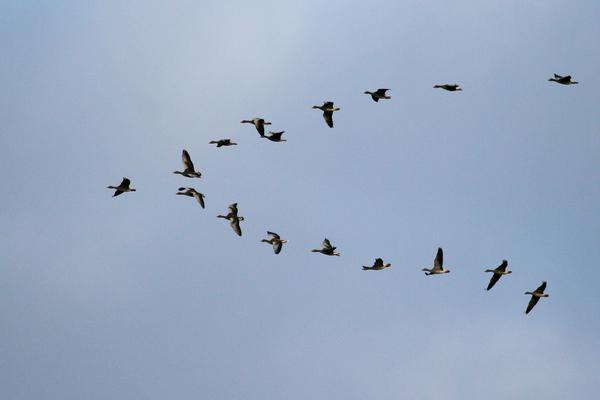Whether we notice it or not, all wildlife prepares for fall and winter in its own way. Squirrels busy themselves collecting nuts, rodents look for shelter, and skunks build burrows. Even bugs spend fall figuring out how they’re going to survive winter. While we’re all figuring out how to prepare for winter, however, some birds decide to escape from it instead. Every fall, thousands of bird species fly hundreds or even thousands of miles to get away from the winter blues. Then, when spring comes, they fly all that distance back. Why do that do that? HOW do they do that?! Here’s everything you ever wanted to know about the amazing journey birds take every year. You’ll never look at the birds in your backyard the same way again!
Why do birds migrate?
The bird species that migrate generally do so twice a year: once in spring, and once in fall. You’re probably familiar with the idea that birds migrate to avoid cold winter temperatures. While that’s true, it’s only part of the full story. Many migratory birds, such as hummingbirds, can actually survive in freezing temperatures. The problem is, the food they eat usually can’t. In both fall and spring, birds migrate to areas where they can most effectively get the resources they need. In fall, birds migrate because the insects, seeds and nuts, or nectar they feed on becomes scarce. They fly south to warmer areas where vegetation and insects aren’t in winter decline. In spring, birds start thinking about nesting. Raising offspring is resource and time-intensive (just like it is for us!). If every bird stayed down south to nest, competition for food would be too fierce. Instead, migratory birds return north to places where they know they’ll be able to nest successfully.
When does migration happen?
The exact timing of migration varies and depends on several factors. An early frost or late spring will alter many birds’ migration schedules, but that’s not all there is to it. Different species migrate to different areas in both spring and fall. Those species also migrate at different times to make sure they arrive at their destinations in peak season. Birds that travel further tend to get started earlier than birds that don’t fly as far away. In general, birds stick around as long as they’re sure they can get the resources they need. The moment they aren’t sure, birds will begin migrating. As for how or why birds decide exactly when it’s time… we aren’t totally sure! Scientists don’t fully understand the mechanics of how birds decide when to migrate. One theory suggests that birds sense *something* about their environment that tells them it’s time to get moving. This “something” could have to do with temperature, changes in light, food availability, or some combination of many factors.How do birds know where to migrate?
Did you know that many migratory birds always take exactly the same route to and from their destinations? Or that some migratory birds actually return to the exact same place year after year? Migratory birds possess astounding navigational “homing” abilities that allow them to travel hundreds of miles without getting lost. The full extent of bird’s navigational abilities is still not fully understood. What do seem clear, however, is that birds apply many different “tools” in conjunction when they’re navigating. Many birds use the sun as a fixed point to keep flying in the same direction. Bird eyes are sensitive to the ultraviolet rays sunlight produces, which are visible even during cloudy days and at night. Some birds can actually sense the earth’s magnetic fields. Many species of migratory birds possess magnetite-based receptors in their beaks. These receptors help the bird intuit true north so they can stay on the right heading. There’s even some evidence that sense of smell may help homing pigeons find where they’re going.






